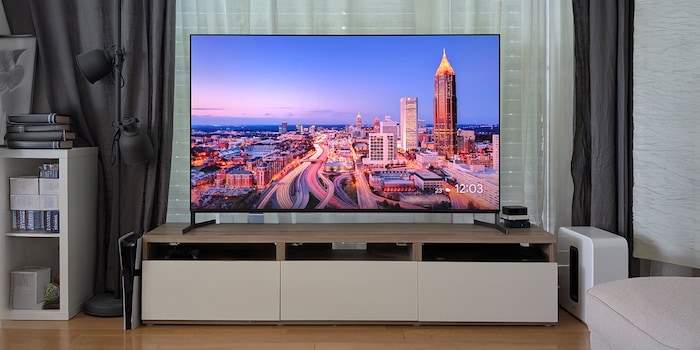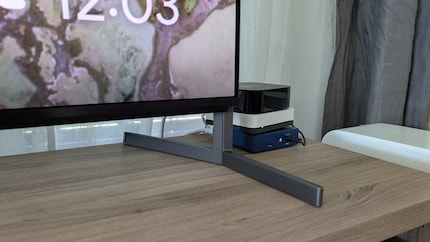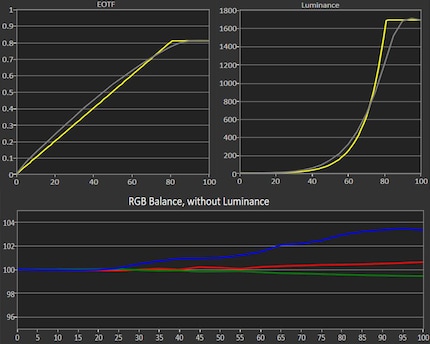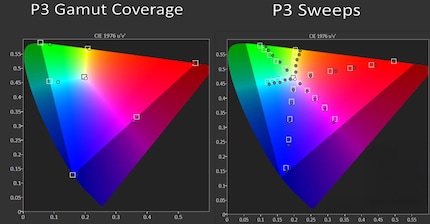
Product test
S95F in review: Samsung's OLED flagship outshines the competition
by Luca Fontana

Sony is back in the OLED game - and how. The Bravia 8 Mark II dispenses with spectacle, but scores with razor-sharp picture quality, clever design and impressive sound. Is that enough for the crown?
Full Disclosure: The TV, the 65-inch version of the Bravia 8 Mark II, was provided to me by Sony for testing. However, Sony has no influence on the test result, my evaluation and the test procedure.
It was 2023 when Sony delivered the best TV I was allowed to test that year with the A95L. Full stop. It had everything: fantastic colours, excellent workmanship and a picture quality that made even Samsung's own QD OLEDs look old.
And then? Nothing. Sony suddenly disappeared in 2024. With the Bravia 9, it preferred to concentrate on its LCD business, while LG experimented with microlens layers and Samsung left the QD OLED stage to Samsung. Now, a year later, Sony is back - and with a bang.
The Bravia 8 Mark II is designed to flatten everything that comes in front of it. No redesign, no spectacle - simply a TV that wants to show that Sony still has what it takes. More brightness, new software tricks, familiar QD OLED power. The only question is: will this still be enough for the crown in 2025?
On the outside, Sony will remain true to itself in 2025. The Bravia 8 Mark II looks confusingly similar to its predecessor - which is no bad thing. Sony has once again opted for slightly inward-sloping feet with a subtle kink at the back. The look remains industrial, but is a little more elegant than last year.
The whole thing is practical anyway. The feet sit on the left and right at the very edge - not in the centre as with many other manufacturers. This creates space: space for wide TV furniture. And above all: space for soundbars. There are around eight centimetres between the bottom edge of the panel and the furniture, enough for most sound bars.

And if you don't have a soundbar? You can also mount the feet flat - so low that it almost looks as if the TV is standing directly on the furniture. Without distance, without distraction. A small but fine detail that shows: Sony is thinking ahead.
About the specs. Sony's Bravia 8 Mark II offers the following:
All four HDMI inputs support HLG, HDR10 and Dolby Vision. Only HDR10+ is missing. What a pity. But its distribution is very low anyway, even if Netflix wants to upgrade in the future. The pass-through function for Dolby Atmos and DTS audio signals is a very positive feature.
About the sound ...
If it were up to Sony, you wouldn't necessarily need a soundbar for the sound. For years, the Japanese company has been relying on its in-house sound technology «Acoustic Surface Audio+»: four drivers installed behind the TV do not vibrate the air like conventional speakers, but the panel itself:
Strictly speaking, this is a 2.2 system. Thanks to digital 3D surround upscaling, it even sounds like more. And it works amazingly well: no other TV produces such a voluminous and clear sound image with its internal speakers. For real surround sound, you still need a home cinema system - but as a TV with integrated sound, Sony's solution is still the best.
Practical: If you have a hi-fi system, you can also use the TV directly as a centre speaker. However, if you continue to use a soundbar, but one from Sony, the TV takes over the treble. This in turn relieves the Sony soundbar, whose free computing capacity improves the sound in the mid and low frequencies. Once again: Sony thinks along well.
What comes next goes deep into the matter. I measure with professional tools from Portrait Display to get an objective categorisation of the image quality. If you are not interested in details and diagrams, you can scroll to the chapter «The picture: Brilliance without gimmickry».
About the measurements. I measured all of the TV's screen modes without calibrating it - just as it comes out of the box. I only made one change to the settings:
As in the previous year, the Dolby Vision mode achieved the best results for all types of content. Except when gaming, for which you should always use Game mode due to the input lag.
2010 nits at two per cent window size, 1780 nits at ten per cent: What Sony tickles out of the panel here is certainly not an economy level, but at least this year it's not top class either. Although the Bravia 8 Mark II shines brighter than I have ever seen from a Sony OLED, it falls short of the G5 (2350 nits), the first tandem RGB OLEDs from LG. It also doesn't quite come close to Samsung's S95F (2110 nits)
The comparison between Sony and Samsung becomes really interesting with larger screens. This is because Sony's panel - i.e. the actual display module - also comes from Samsung's factory. Specifically, while Samsung keeps the brightness up for an astonishingly long time even with a window size of 25 or 50 per cent, Sony reduces the brightness earlier and even falls significantly behind LG. At half the screen size, 445 nits remain, and just 250 nits at full screen. That is visibly less than the S95F (385 nits) or LG's G5 (380 nits).
Sony, which uses the same material as Samsung, is therefore more careful with the software. Probably to avoid overheating and thus burn-in.
For comparison: A mid-range OLED such as the Philips 809 achieves a maximum of 906 nits - and falls back to around 160 nits at full screen. The Bravia 8 Mark II clearly plays in a different league.
Sony remains true to itself with the Bravia 8 Mark II: natural colours, precise gradations and an overall rather neutrally balanced image. The greyscale measurement shows that the EOTF curve is followed well for the most part - with minor deviations at the upper end. From around 75 per cent brightness, the image becomes slightly too bright, which makes Sony's interpretation of HDR highlights appear a little more airy, but not overdone.
The RGB balance is stable over long distances, at least in the visible range. Between 10 and 60 per cent brightness, red, green and blue are close together without any noticeable outliers. From around 65 per cent, blue slowly moves towards the Y value of 105, which is just about acceptable, while green falls slightly behind. The result is a cooler image impression in very bright scenes - not disturbing, but measurable. In dark areas, however, there is a slight green cast, which is typical for QD OLEDs, but is only noticeable on very close inspection.

The average DeltaE value is just over 3, which is still below the maximum acceptable 5. This is therefore absolutely solid. For most viewers, the picture appears precise and harmonious, even if calibration enthusiasts could still optimise individual areas and push the value closer to 1.
I measure the colour space coverage:

Sony therefore achieves almost the maximum in terms of colour space coverage. The fact that the Bravia 8 Mark II falls just short of the 90% target for the BT.2020 colour space is not so bad: even LG's tandem RGB OLED only «» achieved just under 76 per cent here, which is still quite high for a top TV. Only Samsung's S95F even surpassed the brand with its 91.39 per cent.
Reflections cannot be measured directly - but you can see them. And the Bravia 8 Brand II shows that Sony has the matter well under control. Although the reflective glass surface is not matt like Samsung's S95F, it visibly reduces the intensity of direct light sources. Windows, ceiling lamps or other light spots appear less glaring, lose sharpness and are elegantly softened without covering the entire image in a milky colour.
This works particularly well with indirect light or discreetly lit rooms. However, there is a weakness in bright environments: without an additional polarisation layer, the panel tends to have a slight purple tint. In addition, dark content quickly appears washed out - black becomes grey and the contrast flattens out. This reduces the image effect during the day, especially in scenes with lots of shadows or dark backgrounds (below: «Blade Runner 2049»).
The positive remains: The total amount of reflected light is low. The Bravia 8 Mark II manages to minimise most reflections to such an extent that they hardly distract from the content. However, if you want the deepest black even in daylight, you are better off with a matt S95F or a mini LED TV. Nevertheless: for a glossy coated OLED panel, Sony's realisation is solid.
The picture of the Sony Bravia 8 Mark II is impressively bright for an OLED TV and is already pleasantly true to colour ex works - so much for the theory. But how does Sony's new QD OLED flagship perform in practice?
Time for a direct comparison. In addition to the Bravia 8 Mark II, I also tested Samsung's and LG's current top models under the same conditions - Samsung's S95F and LG's G5. Three high-end televisions, two different OLED technologies: one with Quantum Dots, one with Tandem RGB OLED. Who delivers the better picture?
If you want to read the detailed individual tests of the other two models, you can find them here:
How do the three top OLEDs differ in terms of colour rendering? I put them to the test with scenes from «Guardians of the Galaxy Vol. 2», «Avatar: The Way of Water» and «James Bond: Skyfall» - all of them visual heavyweights with strong colours, fine lighting moods and sophisticated skin tones.
The Bravia 8 Mark II remains true to Sony's line: colours are neutral, precise and never appear overdone. HDR content benefits from high brightness and fine tone mapping, skin tones appear differentiated, with a slightly cool restraint - typical Sony. Samsung's S95F, on the other hand, appears a touch warmer, richer and softer and therefore somewhat closer to what LG does with its G5.
Apropos LG: The G5 remains the most emotional of the trio: Ego's palace in «Guardians 2» glows magically golden, the jungle in «Avatar» looks lush green and Bond's face in «Skyfall» takes on an almost nostalgic skin tone. Less realistic perhaps - but beautiful.
Interesting: In the measurements, all three televisions are close to each other in terms of colour fidelity. The fact that they still appear visibly different is probably due to the HDR format: Sony uses Dolby Vision and LG uses Dolby Vision Filmmaker Mode. Samsung doesn't use Dolby Vision, but relies on HDR10 with Filmmaker Mode, which is usually slightly warmer.
How well do the top OLEDs perform in particularly dark or extremely bright film scenes? I tested them with «Blade Runner 2049» and «Jurassic World» - both films that push shadows, highlights and contrast gradients to their limits.
Sony delivers once again in dark scenes. In the dark interrogation between two androids from «Blade Runner: 2049», even the finest structures remain recognisable without the picture brightening or sinking. No black crush, no artificial contrasts - simply deep, clean black with an enormous depth of detail. In a direct comparison, both LG's G5 and Samsung's S95F appear slightly flatter. LG even bogs down in some details, Samsung stays close, but Sony remains the industry leader when it comes to shadow detail.
The picture rotates in very bright scenes: In «Jurassic World», I like LG's G5 the best. The sun remains visible as a sphere, the sky and light reflections look differentiated and vivid. Sony does this well - but not quite as clearly differentiated. And Samsung, of all companies, which once wanted to demonstrate to me how bad LG's brightness gradation was, appears the flattest here. The irony of contrast destiny.
The processor is the brain of the TV. Its main task is to receive, process and display image signals. In doing so, the processor recognises poor picture quality and enhances it by removing noise, boosting colours, smoothing edges, making movements smoother and adding missing pixel information.
Time for the judder test. Judder, i.e. jerking or stuttering during slow camera movements, is a phenomenon that can occur on almost all TVs. The film «1917» by Sam Mendes with its long, steady camera movements is perfect for this. In comparison, pay particular attention to the vertical wooden beams in the barn: do they run cleanly through the picture - or is it jerky?
Sony delivers its very own interpretation here - let's put it politely. The Bravia 8 Mark II looks visibly jerkier than LG's G5 or Samsung's S95F. Even with the film mode set to «Low», there is still a slight jitter in even panning shots. It's clear that Sony doesn't believe in aggressive intermediate image calculation. From the cineastes' point of view, film should be jerky - full stop. After all, Sony itself produces cameras, master monitors and cinema films. They'll probably know best, won't they?
Personally, it's too much purism for me. LG also manages to make movements as smooth as butter and without a soap effect. Samsung is somewhere in between. Sony, meanwhile, is right at the conservative end. For purists, this is consistent. For everyone else, it may simply not be fluid enough.
Now for one of the most demanding tests: how well can the processor improve low-quality sources - such as older Blu-rays, live TV or series like «The Walking Dead»? This was deliberately shot on 16 mm film to create a damaged, post-apocalyptic atmosphere with film grain and image noise.
When upscaling HD or SD content, all three TVs deliver an excellent picture. Sony has always been strong here - and remains so. The Bravia 8 Mark II shows razor-sharp edges, smooth textures and barely visible image noise. Even in dark areas, the picture remains clean, without details drowning or artefacts appearing.
In a direct comparison with LG's G5 and Samsung's S95F, Sony is on a par. Both competitors show slightly softer contours - easy to see if you look at Negan's cheek in «The Walking Dead» with a magnifying glass. On the other hand, they look perhaps a touch more natural, a little less «digitally sharpened».
Bottom line: three TVs at the top level. Anyone who recognises differences here either needs to calibrate professionally - or urgently needs a new hobby.
On the topic of input lag, i.e. the delay between controller input and response on the screen: With the measuring device from Leo Bodnar, I arrive at 16.8 milliseconds on the Bravia 8 Mark II - measured at UHD resolution, 60 frames per second and activated HDR. This is also a good value this year, but significantly higher than LG's G5 (9.7 milliseconds) and Samsung's S95F (10.2 milliseconds). At least the often-cited 20 milliseconds threshold is not exceeded, above which you really notice delays.
To this end, Sony, along with Samsung, LG, Philips, TCL and Panasonic, has entered into a partnership with major game studios. The result is the HGiG - the HDR Gaming Interest Group. According to the manufacturer, the aim is to ensure that HDR is displayed as intended by the game developers, for example when playing «Spider-Man 2» on my PlayStation 5.
The game runs like it's glued to the wall with spider threads. Whether I'm swinging through Manhattan at 120 frames per second, watching the ray-traced reflections in the water or firing one finisher after another in the middle of an HDR thunderstorm: The Bravia 8 Mark II remains poised. No ghosting, no trailing, no artefacts. The picture remains razor-sharp, responsive and colourful. Is the input lag noticeable? Not really. Only with hardcore PVP games are LG and Samsung likely to have the edge.
Sony remains conspicuously reticent when it comes to voice control. It is true that the Bravia 8 Mark II runs on Google TV - and thus on the operating system that is to be equipped with Google's new Gemini voice model later this year. But as of today, there is no sign of it. No Gemini. No smart dialogue. No semantic search.
I nevertheless tested what is currently possible and was bitterly disappointed. While Samsung and LG are at least attempting to integrate Microsoft's Copilot as an AI assistant (with rather moderate success), Sony's solution seems almost Stone Age. It constantly wants to open suitable YouTube videos in response to my requests. Smart search? Not a chance. Complex commands? Not a chance.
Sony would have potential here - after all, Google and Gemini are based right here. But apparently the big voice model update will come later. Until then, the vision of an intelligent assistant remains more of an empty promise than real added value, even at Sony.
The Bravia 8 Mark II is Sony's statement after a year's break from OLED. And what a statement it is. The Japanese company has delivered a device that doesn't bring a revolution into the living room, but delivers a superior performance in almost all areas - and very deliberately avoids gimmickry.
The picture? Bright, precise and wonderfully balanced. Especially in dark scenes, the Bravia 8 Mark II shows why Sony has been the reference for years. The sound is also convincing, the design is well thought out and the workmanship is impeccable. In short: a television for people who are not looking for spectacle, but for class.
Nevertheless, there are some minor points of criticism: the intermediate image calculation is not to everyone's taste, and the brightness on large surfaces lags behind somewhat. Officially, I award 5 out of 5 stars - due to the system. It's actually four and a half, because although Sony offers an outstanding overall package, it is just behind LG's and Samsung's top OLEDs in terms of peak brightness, intermediate image calculation and gaming.
Pro
Contra
I write about technology as if it were cinema, and about films as if they were real life. Between bits and blockbusters, I’m after stories that move people, not just generate clicks. And yes – sometimes I listen to film scores louder than I probably should.